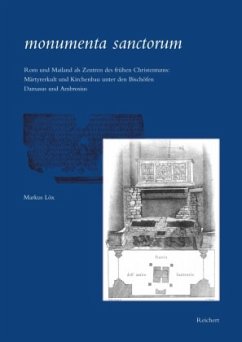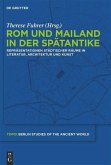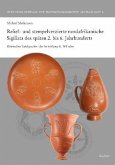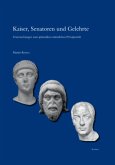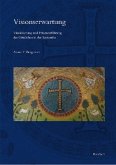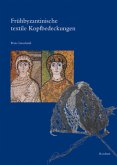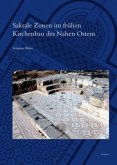This study compares the building projects, written and epigraphical testimonies, and performative actions of two outstanding figures among fourth century bishops, Damasus and Ambrosius. These monumenta sanctorum worked as catalysts of the emerging cult of the martyrs. Moreover, the different manifestations of episcopal presence, some of which are here examined critically for the first time, illustrate the influence of the two bishops on the process of christianisation in their dioceses, Rome and Milan. Using partly different strategies, they both had a large part in the development and representation of a local Christian history. Their approach in this served as a model for numerous other cities and shaped the Christian cult of the saints into the Middle Ages and beyond.
Hinweis: Dieser Artikel kann nur an eine deutsche Lieferadresse ausgeliefert werden.
Hinweis: Dieser Artikel kann nur an eine deutsche Lieferadresse ausgeliefert werden.
"Abschließend eint beide die Instrumentalisierung der monumenta sanctorum zur Stärkung ihrer Stellung in innergemeindlichen Konflikten. Damasus' Maßnahmen sind zusätzlich vom Primatanspruch des römischen Bischofssitzes bestimmt, wohingegen Ambrosius die Sicherung der eigenen niemoria stärker ins Zentrum stellte. Leben und Werk der bei den Bischöfe Damasus und Ambrosius gelten als vermeintlich erschöpfend untersucht. Durch die angewandte Methode eines personalisierten Vergleichs gelingt es dennoch u. a. deren Strategien zur Sicherung der eigenen Stellung oder zur Inszenierung von Heiligkeit zu erhellen. Die dabei gemachten, neuen Beobachtungen und Erkenntnisse tragen zum besseren Verständnis des Christianisierungsprozesses und der Entwicklung des Märtyrerkultes im Allgemeinen bei. Die zukünftige Rolle des Bischofs und die Grundlagen seines teilweise überregionalen Einflusses werden in der zweiten Hälfte des 4. Jahrhunderts von Damasus und Ambrosius nachhaltig geprägt. Daher erläutert die vorliegende Detailstudie Mechanismen bischöflicher Vergegenwärtigung, die auch außerhalb Roms und Mailands zu finden sind und weit über die Spätantike hinaus Gültigkeit behalten sollten. Dieses Buch liefert somit eine wichtige Grundlage für weitere Untersuchungen zum Bischofsamt und zum christlichen Heiligenkult."
In: KunstbuchAnzeiger.de, März 2014.
-------------------------------
"Monumenta sanctorum is a sober and careful study. Löx is surely right to draw attention to the ambiguities inherent in the epigraphic, archaeological, and literary data, though undoubtedly he will elicit disagreement on specific points. Nevertheless, his eVidential conservatism only makes more convincing his demonstration of the roles played by the book's two protagonists in the formulation of late ancient martyr cult and the attendant remapping of the classical city. That the means employed by Damasus and Ambrose diverged in several ways and that immediate pressures as well as larger opportunities influenced their aims should perhaps now come as no surprise. It is the contribution of this book, however, to help us see more clearly how such local histories might relate both to one another and to broader trends."
Von: Denis E. Trout
In: Sehpunkte. Renzensionsjornal für Geschichtswissenschaften, http://www.sehepunkte.de/2015/09/26020.html, 27.11.2015.
--------------------------------------
"Dr. Löx has produced a book that brings a lot of information together and makes important contributions to our understanding of the Christianization of Roman society, the growing power of Christian bishops, and the formalization of the cult of the saints. Whereas previous scholarship has been focused on particular aspects of the careers of these bishops, their patronage or their writings, or the poetry of their epigrams, Löx uses a holistic approach to tie their deeds together in a way that allows the reader a clear view of each man's overall contributions and the motivations behind them. If there is something missing, it is that the work of other contemporary bishops is not examined to provide an even wider context. Löx focuses on two of the more important and interesting bishops of Late Antiquity but it would be both interesting and helpful to see some comparison with the bishops of other Christian centers at Constantinople, Antioch, Alexandria and Jerusalem. Paulinus of Nola, also engaged in the promotion of the cult of saints in his city at the end of the fourth century, is briefly mentioned, but could easily be brought into the discussion at the heart of the book. Nevertheless, Professor Löx has made a good start in the reassessment of the role of bishops with his choice of Damasus and Ambrose. The book is very well researched, written, and illustrated and is nicely produced by Reichert. It will be an important resource for anyone interested in these two men, the cult of saints, or the large issues of Christianity and its art and architecture of the second half of the fourth century."
Von Mark J. Johnson
In: http://bmcr.brynmawr.edu/2015/2015-05-37.html, 01.06.2015
--------------------------------------
"L.s Studie fügt sich in eine ganze Reihe neuerer Untersuchungen zur bischöflichen Selbstrepräsentation in der Spätantike und der Funktionalisierung der Märtyrerverehrung ein. Der spezifische Reiz der Arbeit von L. liegt im Vergleich der Bischofssitze von Rom und Mailand, ihre Stärke in der Berücksichtigung archäologischer und literarischer Dokumente, wodurch wechselseitige Erkenntnisse und Korrekturen möglich werden. So gelingt es dem Vf, zu durchaus neuen Ergebnissen im skizzierten Forschungsgebiet zu gelangen und Perspektiven aufzuzeigen, die Gegenstand zukünftiger Untersuchungen sein werden."
Von Christian Hornung
In: Theologische Revue Nr. 2, Jahrgang 110, 2014, S. 130.
In: KunstbuchAnzeiger.de, März 2014.
-------------------------------
"Monumenta sanctorum is a sober and careful study. Löx is surely right to draw attention to the ambiguities inherent in the epigraphic, archaeological, and literary data, though undoubtedly he will elicit disagreement on specific points. Nevertheless, his eVidential conservatism only makes more convincing his demonstration of the roles played by the book's two protagonists in the formulation of late ancient martyr cult and the attendant remapping of the classical city. That the means employed by Damasus and Ambrose diverged in several ways and that immediate pressures as well as larger opportunities influenced their aims should perhaps now come as no surprise. It is the contribution of this book, however, to help us see more clearly how such local histories might relate both to one another and to broader trends."
Von: Denis E. Trout
In: Sehpunkte. Renzensionsjornal für Geschichtswissenschaften, http://www.sehepunkte.de/2015/09/26020.html, 27.11.2015.
--------------------------------------
"Dr. Löx has produced a book that brings a lot of information together and makes important contributions to our understanding of the Christianization of Roman society, the growing power of Christian bishops, and the formalization of the cult of the saints. Whereas previous scholarship has been focused on particular aspects of the careers of these bishops, their patronage or their writings, or the poetry of their epigrams, Löx uses a holistic approach to tie their deeds together in a way that allows the reader a clear view of each man's overall contributions and the motivations behind them. If there is something missing, it is that the work of other contemporary bishops is not examined to provide an even wider context. Löx focuses on two of the more important and interesting bishops of Late Antiquity but it would be both interesting and helpful to see some comparison with the bishops of other Christian centers at Constantinople, Antioch, Alexandria and Jerusalem. Paulinus of Nola, also engaged in the promotion of the cult of saints in his city at the end of the fourth century, is briefly mentioned, but could easily be brought into the discussion at the heart of the book. Nevertheless, Professor Löx has made a good start in the reassessment of the role of bishops with his choice of Damasus and Ambrose. The book is very well researched, written, and illustrated and is nicely produced by Reichert. It will be an important resource for anyone interested in these two men, the cult of saints, or the large issues of Christianity and its art and architecture of the second half of the fourth century."
Von Mark J. Johnson
In: http://bmcr.brynmawr.edu/2015/2015-05-37.html, 01.06.2015
--------------------------------------
"L.s Studie fügt sich in eine ganze Reihe neuerer Untersuchungen zur bischöflichen Selbstrepräsentation in der Spätantike und der Funktionalisierung der Märtyrerverehrung ein. Der spezifische Reiz der Arbeit von L. liegt im Vergleich der Bischofssitze von Rom und Mailand, ihre Stärke in der Berücksichtigung archäologischer und literarischer Dokumente, wodurch wechselseitige Erkenntnisse und Korrekturen möglich werden. So gelingt es dem Vf, zu durchaus neuen Ergebnissen im skizzierten Forschungsgebiet zu gelangen und Perspektiven aufzuzeigen, die Gegenstand zukünftiger Untersuchungen sein werden."
Von Christian Hornung
In: Theologische Revue Nr. 2, Jahrgang 110, 2014, S. 130.

